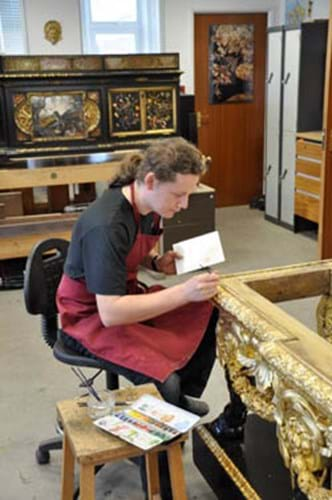
A cast iron royal provenance underlies the importance of the Alnwick cabinets. Commissioned by Louis XIV, designed by Charles Le Brun, made at the Gobelins by Domenico Cucci and delivered to the palace of Versailles in 1683, they are the only fully-documented Sun King cabinets in existence today.
At the height of his career in Paris, the Italian artist Domenico Cucci (1640-1705) was producing arguably the most extravagant and most expensive furniture of all time. However, changing fashion and their inherent fragility dictated that much was dismantled. Indeed, during the 1740s, many of the Louis XIV pietra dura furnishings at Versailles were sent to the newly established natural history museum in Paris. The polished stones were removed for display in the minerals gallery.
The Alnwick cabinets, sold from the French royal collection in 1751 (and restored in 1753), are first mentioned among the chattels of the Duke of Northumberland in a bill sent to the 3rd Duke in 1822. The following year the stands were re-gilded and two new ebonised plinths made to allow for better display in the Saloon at Northumberland House in London, where the cabinets were kept until 1874, when the house was demolished; 1823 was the last time they were restored.
The cabinets remain in largely original condition. However, furniture combining wood with hard stone marquetry is extremely sensitive to climatic change and air pollution, and the pair were in urgent need of conservation to stabilise lifting inlays caused by the drying out of original adhesives.
A panel of curators and conservators from the Duke of Northumberland's collection, the Victoria & Albert Museum in London, the National Trust and Versailles formed a plan of action and the treasures were sent to Yannick Chastang's Sittingbourne workshop in July 2009.
Twenty-first century conservation (all of it fully and easily reversible) is a fascinating combination of cutting-edge science and traditional techniques.
Carefully re-applying the hardstone decoration involved matching then modifying the original wax-based glue to improve its compatibility with wood and stone. Where previous repairs had been made using an inappropriate adhesive, these unstable areas were carefully un-restored and consolidated. The monkey marquetry panel was a challenge. Previously restored with plaster, it was entirely lifted from its slate backing before the plaster could be removed and replaced with the wax adhesive.
By using solvent fumes and poultices of a neutral cleaning agent, the mercury gilded bronze mounts, exposed to high levels of air pollution while the cabinets resided in Victorian London, were cleaned without damaging the gilded surface layer.
Xr-F analysis, only available to the conservation community for around five years, was used to determine the precise composition of the alloy. A database of results is being created that will help determine the differences between, for example, 17th, 18th and 19th century bronze: already Mr Chastang said the Xr-F results from the Alnwick Castle cabinets are helping firm up other pieces in museums and private collections.
To ensure the recently-cleaned mounts do not appear too garish - and to create more depth to the chasing of the gilded sculptural elements - they were treated with a final protective application of coloured wax, a method known in the 18th century as mise en couleur de l'or.
Section analysis (and the recent emergence at a Paris flea market of two early 18th century coloured engravings of the cabinets) showed that the dark green paint to the distinctive carved ox legs was old but not original, while it emerged the stand had in fact been re-gilded twice since the late 17th century.
As the original Louis XIV water gilding was extremely damaged, it was decided to preserve and clean the 1823 gilding layer that proved to be in better condition than first expected. "Conserving gilded furniture always presents the interesting challenge of knowing where to stop," commented Mr Chastang.
From start to finish the work took almost a year and a half and involved the input of four conservators. The newly restored cabinets, currently awaiting photography, will be on view at Alnwick Castle from April 1.
By Roland Arkell




